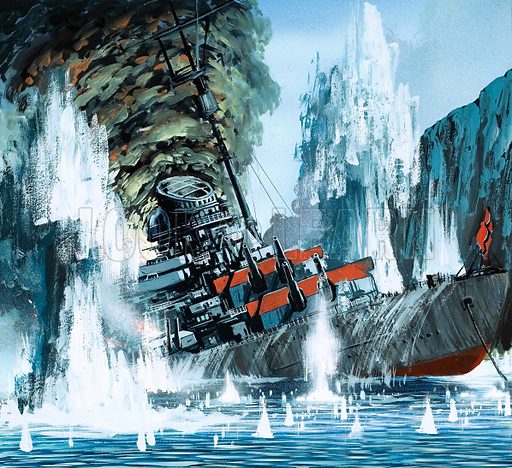
|
For more articles like this go to the Look and Learn articles website. |

Perils awaited Germany’s submarines in the Bay of Biscay where the curved coasts of France and Spain meet the Atlantic. During the Second World War, Britain and her allies sank so many enemy submarines in the bay that the German crews grimly called it “the black pit.”
Their chief threat came from aircraft armed with depth charges, for it took even a good submarine crew a few vital seconds longer to crash dive than it did for the aircraft to attack. Faced with this threat, Admiral Karl Doenitz, commander of the U-boats, was forced to re-think his tactics. One of his weapons which had a short success was an acoustic torpedo designed to home-in on the sound of a surface ship’s propellers. But this was defeated when the Allies found a counter-measure to it. Doenitz then fitted the submarines with more anti-aircraft guns and ordered them to fight it out on the surface. This was called the aircraft trap, with a small number of submarines running together for massed firepower, but it was a submarine trap instead. All the aircraft had to do was to circle out of range of the guns and radio for air reinforcements or call up the nearest group of hunting ships.
What Doenitz needed was a super-submarine or a better submarine which was fast underwater and could stay under for the whole of its patrol. It would have to be able to run its main engines while submerged and somehow allow the engines and crew to breathe underwater. A scientist, Professor Walter, tested a boat which used concentrated hydrogen peroxide as fuel and could run submerged at almost 30 knots, faster than most Allied escort ships. But it was rejected because of the enormous expense of producing its fuel. Walter’s other development proved to be the key to the problem. This was the Schnorkel, a technically advanced version of the breathing tube you can use with a mask for underwater swimming.
Mounted on a periscope mast, the schnorkel allowed the submarine’s diesel engines to suck in air and blow their exhaust gases clear of the boat. Two new submarines were designed to take full advantage of the schnorkel the types XXI and XXIII. The big XXI was to take over the Atlantic war and the XXIII was to take on coastal patrols.
Streamlined for underwater speed, the XXI was a deadly weapon which could run submerged at 15-16 knots and its diesel engines were used to charge massive electric batteries. It was fitted with silent running motors to allow it to move at five knots to escape detection by enemy listening devices. The torpedo armament consisted of six bow tubes which fired their weapons angled downwards so that they left no tell-tale track on the surface. No fewer than twelve more tubes faced rearwards so that the submarine could fire a salvo while making its getaway at high speed.
At the end of the war, the Allies found rows of XXI boats in Bremen shipyards being built in sections for speed. But all had been damaged by air attack.
If these vessels had been ready in large numbers in 1944 (as had been planned), they might well have destroyed the Allied supremacy of the high seas. One of the XXI boats left harbour on patrol in April, 1945, when the war was about to end. It avoided Allied sea and air patrols with ease and made an undetected dummy attack on a British cruiser.
However, life was uncomfortable on a schnorkel-equipped submarine. In a rough sea, the schnorkel’s valve would close when it went underwater and the diesel would draw air from the submarine’s interior. When the schnorkel was above the water again, air rushed in, creating a continuous series of painful differences in pressure.
There were several counter measures that beat the submarines:
ASDIC. Named after the initials of the Admiralty Submarine Detection Investigation Committee, this device was carried on a surface ship. It transmitted through the water a supersonic wave which was echoed back to the transmitter by any solid object. Using it, a trained operator could give a submarine’s range and bearing accurately.
HF/DF. High frequency/direction finding equipment on ships and shore stations picked up the brief radio messages from a U-boat and gave a fix on its position.
RADAR. Special sets on ships and aircraft could locate a submarine’s conning tower or even, in good conditions, its periscope.
“HEDGEHOG.” This fired 24 smalli-mortar bombs in a pattern ahead of the ship. The bombs exploded only on contact, so a hit was obvious.
SONOBUOY. This small listening device floated on the surface and picked up any underwater noise made by a submarine and transmitted it by radio to searching aircraft above.
LEIGH LIGHT. An intensely bright and powerful searchlight was fitted under an aircraft’s wing to make it possible to attack U-boats at night.
Many navies developed midget submarines during the Second World War. Most were designed to be carried or towed by big submarines until they were close to their target. The Japanese used them in their attack on American shipping in Pearl Harbour, and the Italians used their two-man torpedoes to strike at two British battleships in Alexandria Harbour. Both these actions took place in December, 1941.
The British used two-man submarines to place a time bomb under an enemy ship. The same method was used later in the X-craft, a four-man submarine which carried two bombs on its sides. Two of its successes were the crippling of the “Tirpitz” in Norway and the Japanese cruiser, “Takao,” in Singapore.
Towards the end of the war, the Germans and Japanese planned and used many types of midget submarines of all shapes and sizes, some being virtually manned torpedoes.